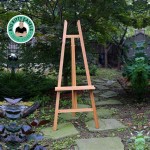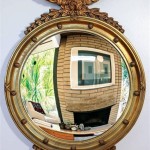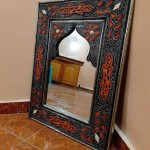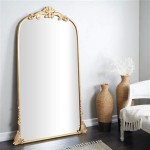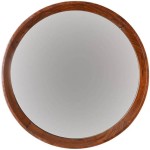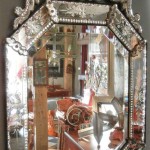Dressing Table Mirror Measurements: A Comprehensive Guide
Choosing the right dressing table mirror involves more than just aesthetics. Practical considerations, such as size and placement, play a crucial role in functionality and overall bedroom design. Understanding the various measurements involved is essential for a satisfying purchase.
Key Mirror Dimensions
Three primary measurements define a dressing table mirror's size: width, height, and depth. Width refers to the horizontal dimension, height to the vertical, and depth to the thickness of the mirror itself. Depth is less critical for wall-mounted mirrors but crucial for freestanding or tabletop options.
Standard Dressing Table Mirror Sizes
While custom sizes are available, standard dimensions offer a convenient starting point. Common widths range from 30cm to 120cm, catering to various table sizes and individual needs. Heights typically range from 40cm to 80cm, accommodating seated and standing views. Standard depths, for mirrors with frames or backing, typically range from 2cm to 5cm.
Matching Mirror and Table Proportions
A harmonious relationship between the mirror and dressing table dimensions is vital. Ideally, the mirror's width should not exceed the table's width. A slightly narrower mirror can create a sense of balance, while an overly large mirror can appear overwhelming. The mirror's height should complement the table's height and the user's seated position, allowing for a comfortable view.
Considering the User's Height
The user's height is a crucial factor in determining the ideal mirror height. The mirror should be positioned to allow the user to see their face and upper body comfortably while seated. This often means the center of the mirror should be at eye level when seated at the dressing table. Taller individuals may require taller mirrors or higher table placements.
Different Mirror Styles and Their Measurements
Various mirror styles influence measurement considerations. Wall-mounted mirrors offer flexibility in height placement but require careful width selection relative to the table below. Tabletop mirrors offer portability and adjustable angles, with size dictated by available table space. Freestanding mirrors, often including storage, require floor space considerations and offer integrated mirror and table solutions. Their dimensions encompass the entire unit.
Measuring for a Wall-Mounted Mirror
For wall-mounted mirrors, measure the dressing table's width and determine the desired mirror width based on proportional guidelines. Measure the wall space above the table to ensure adequate height clearance. Consider the user's seated eye level to determine the optimal mirror placement height.
Measuring for a Tabletop Mirror
Tabletop mirrors require measuring the available surface area on the dressing table. Ensure sufficient space for the mirror base and any accompanying accessories. Consider the mirror's height in relation to the user's seated position, ensuring comfortable viewing angles.
Measuring for a Freestanding Mirror
Freestanding mirrors necessitate measuring the available floor space in the bedroom. Consider the unit's overall width, height, and depth to ensure it fits comfortably within the room without obstructing walkways or other furniture. Assess the mirror's height in relation to the user's height, ensuring comfortable usage.
Importance of Accurate Measurements
Accurate measurements are paramount to a successful dressing table mirror selection. Incorrect measurements can lead to a mirror that is too large or too small, disrupting the room's aesthetic balance and hindering functionality. Careful planning and precise measuring ensure a well-proportioned and practical setup.
Utilizing a Measuring Tape
A standard measuring tape is an essential tool for obtaining accurate dimensions. Measure both the dressing table and the intended mirror space carefully. Record the measurements in a notebook or on a digital device to avoid confusion or errors. Double-check measurements for accuracy before making a purchase.
Visualizing Mirror Placement with Tape
Using painter's tape can help visualize a mirror's placement and size before committing to a purchase. Mark the intended mirror dimensions on the wall or tabletop using tape. This allows for a realistic assessment of the mirror's proportions within the space and assists in identifying potential placement issues.
Consulting Product Specifications
Always refer to the manufacturer's product specifications for precise mirror dimensions. These specifications provide detailed information on width, height, and depth, ensuring accurate comparisons between different models. Verify compatibility with the dressing table and the available space based on these specifications.
Considering Frame and Bevel Sizes
Framed mirrors add an extra dimension to the overall measurements. Factor in the frame's width and depth when calculating the mirror's total dimensions. Beveled edges also contribute to the overall size, albeit subtly. Account for these additions to ensure accurate fit and placement.

Dressing Table 39 5 Wide Vanity With Mirror Gkw Retail

Artiss Dressing Table Mirror Stool Jewellery Cabinet Makeup Organizer Drawer Myer

Standard Sizes And Dimensions Of Home Furniture Dressing Table Design Sketches

Tyssedal Dressing Table Mirror Plans Furniture Design Sketches Floor Plan Symbols

Standard Sizes And Dimensions Of Home Furniture Dressing Table Simple Design

Standard Sizes And Dimensions Of Home Furniture Engineering Discoveries Dressing Table Mirror Design Small Washroom

Wooden Makeup Jewelry Dressing Table With Sliding Mirror Drawer Buyerempire

Modular Handmade Brown Engineered Wood Dressing Table With Mirror Dimension L W H 600x300x1800 Inch In At Best Delhi Victus Retail Pvt Limited

Dressing Mirror Size Dimension Width 23 Inches Depth 14 Height 78 At Rs 13824 In Ratangarh

Geneva Dressing Table With Mirror Stool Rawat Furniture

